Yesterday: Nevada Mines Yield Great Wealth
May – June 2019
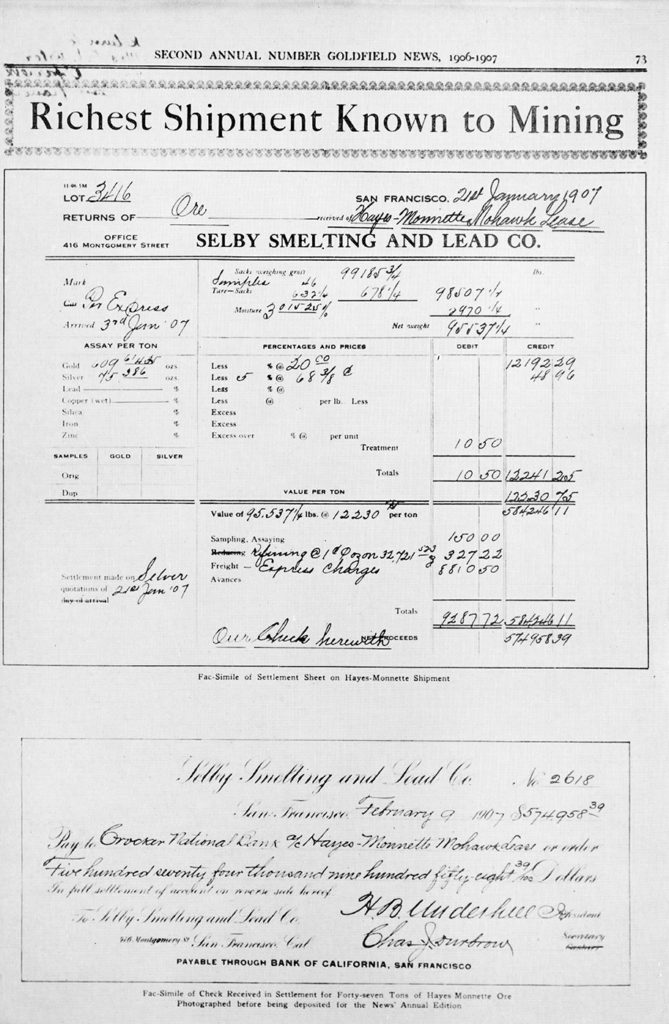 This story originally ran in the May/June 1939 issue of Nevada Magazine.
This story originally ran in the May/June 1939 issue of Nevada Magazine.
Mining has been recognized as one of Nevada’s major industries since the very beginning of its settlement. From the time when gold was first discovered at the mouth of Gold Creek Canyon, near Dayton, in Lyon County, back in 1849, down to the present day this industry has consistently held its position of leadership. A conservative estimate, made from official records and other reliable sources, reveals the fact that new wealth produced from the ground through the working of mines for metals of all kinds in the Sagebrush State has reached the astounding sum of $1,600,000,000. And this figure does not include the nonmetallics which have, in recent years, assumed increased importance and commercial value.
At first prospectors sought only gold and silver. As the State progressed and uses for other metals developed the field of activity was greatly expanded.
Discovery and widespread use of electricity brought on greater demands for copper. This demand also affected zinc and lead. The need for a greater variety of metals was constantly broadened as other inventions and appliances in industry created new markets for less-common metals. Metals and nonmetallic ores unknown or unsuspected of having any value by the early prospector and miner came into broad industrial use, assumed a prominence comparable to precious metals, were later found in large deposits, and partially explored, followed by production which added materially to the new wealth of the State.
The peak of production has not yet come into sight, for despite the enormous quantities of gold, silver, copper, lead, zinc and other metals taken from Nevada’s hills, according to men of science, the surface hardly has been scratched.
At first it was the Comstock Lode at Virginia City The story of that camp and the fabulous recoveries of silver and gold often has been told. Its magnitude justified the repetition. Finding and extracting the Comstock ores brought great riches to the State as well as to the Nation. Its flush production era has been an outstanding epoch in Nevada history The Comstock still stands as one of the greatest gold and silver producing districts in the entire world.
Then came hundreds of other places. Into the desert country the pioneers moved in all directions. Under the broiling sun or through the beating blizzard the search for gold went on. Excitement ran high. Lucky prospectors, with nothing but a grubstake and only a fragmentary knowledge of ores and their mode of occurrence, found rich diggings and became wealthy Outcroppings of rocks showing high values in both gold and silver virtually blocked their pathway. Under such conditions, in a virgin field of exploration, the chance of making new finds prevailed which are lacking in present-day prospecting. It seems these hard-living men of the West didn’t pass up much of value which showed above ground.
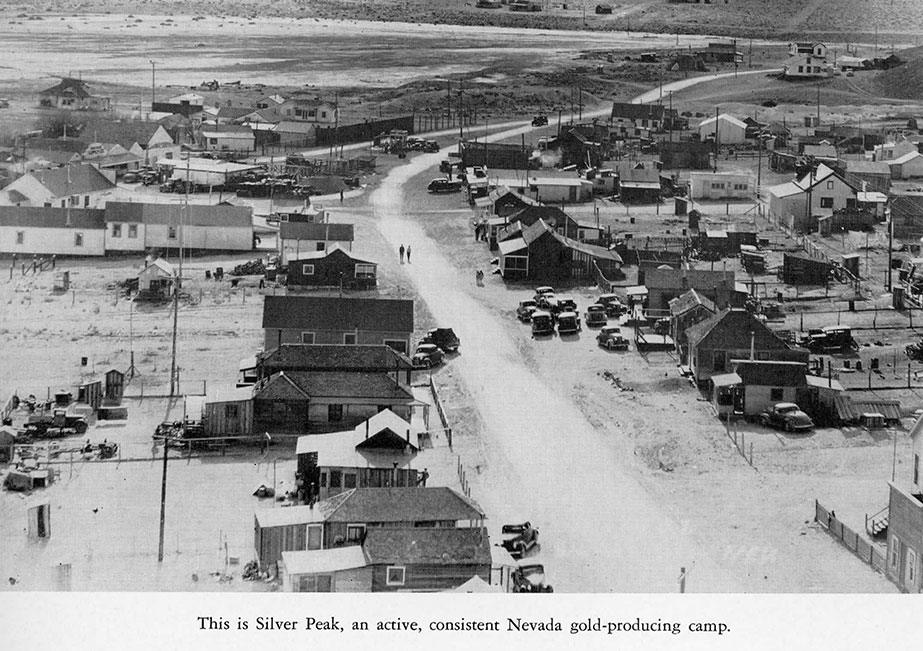 As a result, one by one, new ore deposits were disclosed and new districts established. Spreading from the site of the original discovery prospectors opened “prospects” in the 1850s, and 1860s, and later, which reached to all corners of the State. Eureka, Austin, Treasure Hill, Hamilton, Ely, Jarbidge, Tonopah, Goldfield, Rhyolite, Searchlight, Rawhide, Silver Peak and a score of others are outstanding camps which came after Virginia City to contribute their share to the wealth and glamour of Nevada’s mining industry.
As a result, one by one, new ore deposits were disclosed and new districts established. Spreading from the site of the original discovery prospectors opened “prospects” in the 1850s, and 1860s, and later, which reached to all corners of the State. Eureka, Austin, Treasure Hill, Hamilton, Ely, Jarbidge, Tonopah, Goldfield, Rhyolite, Searchlight, Rawhide, Silver Peak and a score of others are outstanding camps which came after Virginia City to contribute their share to the wealth and glamour of Nevada’s mining industry.
Silver during the early days brought a good price. In fact, many silver mines proved as profitable, if not more so, than many camps where gold extraction predominated.
At Virginia City it was lode gold found in place in the natural rock. In other districts it was placer gold. Whether lode or placer gold, or even silver, mattered little, for the finding of either stirred the prospectors into renewed action.
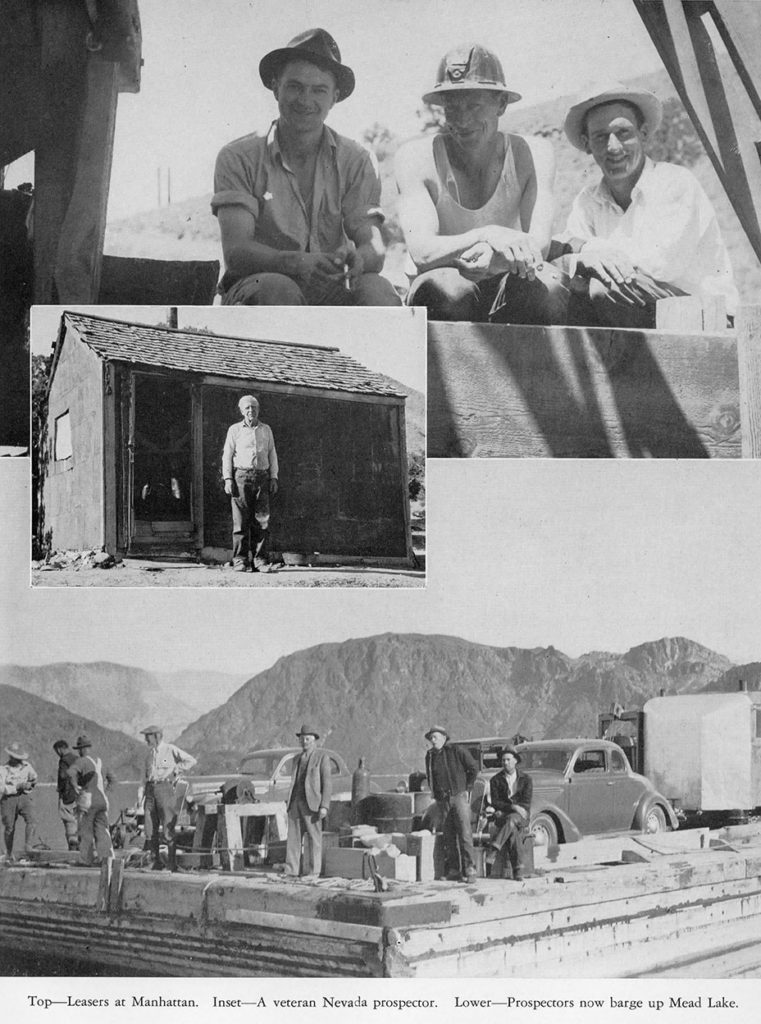 When electricity made its advent and changed the entire mode of human life, copper came into extraordinary demand. Supplies from the mines in the Old World became inadequate and the New World was called upon in the emergency New sources of supply were needed and Nevada was a favorable region for copper deposits. This increased need for an old metal stimulated anew the interest of Nevada prospectors to search for the red metal. As a result, copper deposits in many sections of the State were found.
When electricity made its advent and changed the entire mode of human life, copper came into extraordinary demand. Supplies from the mines in the Old World became inadequate and the New World was called upon in the emergency New sources of supply were needed and Nevada was a favorable region for copper deposits. This increased need for an old metal stimulated anew the interest of Nevada prospectors to search for the red metal. As a result, copper deposits in many sections of the State were found.
Near Ely, in eastern Nevada, beds of lowgrade copper ore were disclosed. Development began and was vigorously pushed. The extent of these deposits justified production on a large scale. The magnitude is indicated by the fact that these beds still yield millions of dollars in new wealth annually to the State and Nation. Copper ore has been taken from this site for more than 3 5 years. The district has produced millions of pounds of copper in the past, and the present known remaining supply is sufficient to assure the operators a production for years to come.
Edison’s discovery and practical application of electricity also affected the status of lead and zinc. Many uses for these two base metals have been found since chat momentous revelation. And again the hills of Nevada disclosed some of their secrets to the courageous prospectors, and indicated where large deposits of these metals could be spotted and worked.
Principal lead and zinc producing mines in Nevada at present are located near Pioche, Lincoln County For 20 years these mines have been passing through a period of exploration and development. As a result of these investigations it is now definitely known chat the Lincoln County lead and zinc deposits are some of the largest in the world. They are of such extent, in fact, that capacity production is expected to shift the balance of supply in America to this western field.
As research and experiment resulted in the disclosure of one invention after another during the past half century, greater need for other metals in industry became more general. Some of these metals were uncommon and were believed to be limited in quantity Their need, however, was definitely established, eventually a place was found for their use, and their value enumerated. Those who searched Nevada’s hills knew little or nothing of their composition, method of occurrence or worth until these metals suddenly assumed a vital position in the modern mechanical world.
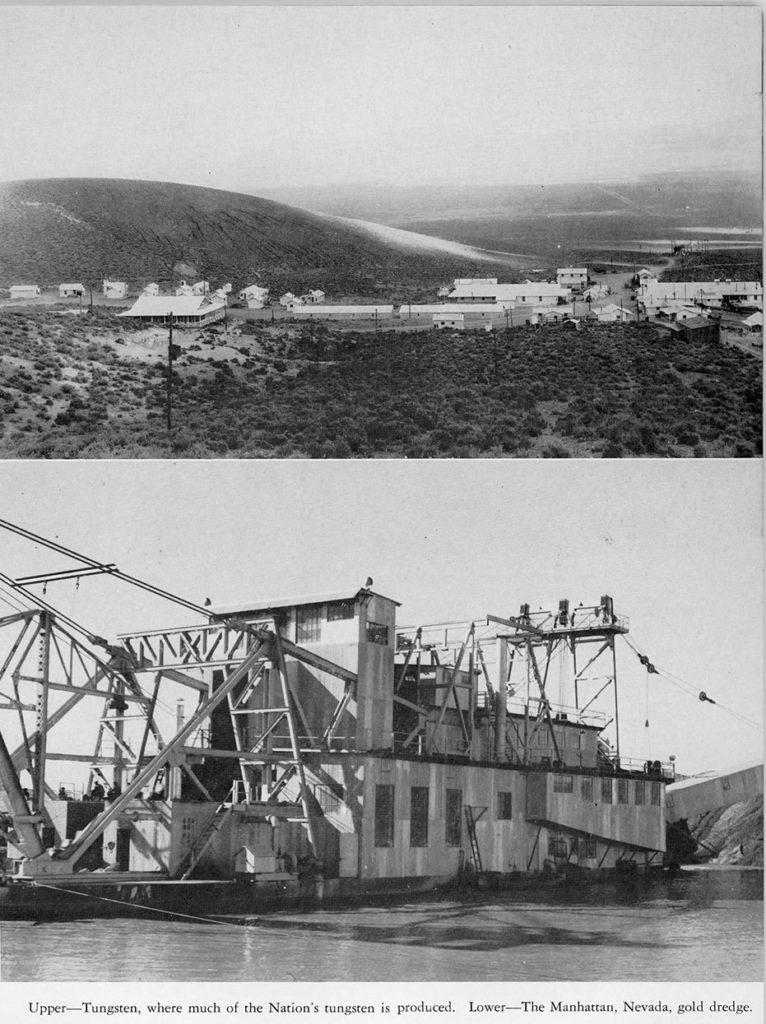 Of these, probably tungsten and dumortierite are two of the more important as they relate to Nevada mining. Both of these materials are found in the State in generous quantities.
Of these, probably tungsten and dumortierite are two of the more important as they relate to Nevada mining. Both of these materials are found in the State in generous quantities.
Tungsten has many uses in the industrial field and is best known for its use as a filament in incandescent electric light bulbs, but a wider use is that of an alloy in the manufacture of steel cools. Since attaining prominence in industry, tungsten deposits of great potential value have been found in Nevada. One mine alone, in Pershing County, supplies nearly 60 percent of the Nation’s domestic production annually. At this time the United States is forced to import additional tungsten to meet its industrial demands.
Until the automobile made its appearance on the world’s highways little was known about dumortierite, and its use was very limited. This use was confined particularly to the field of ceramics. Because it possesses great heat-resisting properties when used as the porcelain in the manufacture of spark plugs for motor cars and airplanes, discovery and development of this mineral has meant much to Nevada. The dumortierite found in Pershing County is the only known commercial deposit of its kind in the world today.
While more importance is attached to the common metals, Nevada also produces limited amounts of nickel, antimony, bismuth, and molybdenum. Deposits of these metals having considerable value are known to exist in the State. Future development alone will determine the real extent or actual worth.
Cinnabar, the common ore of mercury, is also found in some of Nevada’s many hills. Large ore bodies containing the liquid metal are successfully worked.
Very little platinum is produced in the State. Small amounts of this heavy white metal were recovered years ago, but the platinum was usually found associated with other metals and extraction was difficult.
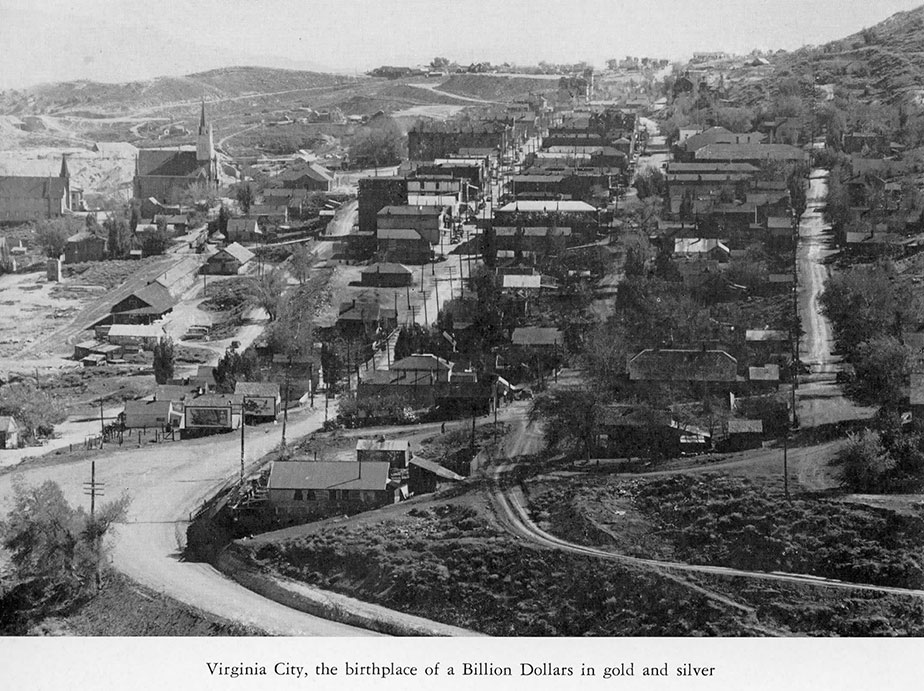 Some coal is mined in the west central part of the State. Production is limited, although the fields are said to be extensive and the coal is of good quality.
Some coal is mined in the west central part of the State. Production is limited, although the fields are said to be extensive and the coal is of good quality.
Tin, in limited quantities, has been mined in the State. Deposits are widely scattered and production has been small.
Nature has stored millions of barrels of oil and gasoline in shale rocks in Elko, Eureka, Nye and White Pine Counties. Mountains of oil shale exist which await economical reduction. Some years ago a refining works at Carlin, Elko County, made very successful tests and secured a high-grade gasoline from this shale treated in its plant. Production cost while using the old process was considerably higher than the cost of refining natural petroleum obtained from the Nation’s oil wells. As a result the product at Carlin faced a strong disadvantage in competing with natural petroleum products. Since that time new processes have been evolved which are more economical in operation. The supply of oil shale in Nevada seems limitless, and when the natural oil wells become exhausted future generations can still rely upon Nevada’s oil shale for its share of needed fuel oil.
In addition to the precious and the baser metals a great variety of nonmetallics are found in the Nevada portion of the Great Basin area. These include diatomaceous earth, glass and foundry sands, limestone, bentonite, brucite, gypsum, and many others.
Diatomaceous earth, a base ingredient for tooth powder and also for cosmetics, occurs in scattered parts of the State, perhaps more abundantly in the northern portion. Glass and foundry sands of excellent grade are mined in the Virgin River Valley near Overton, Clark County. There is a large plant near Sloan, in the same county, which has a large output of limestone and dolomite. Bentonite is used principally as a sealing material in the oil fields. It is shipped from Mina, Mineral County.
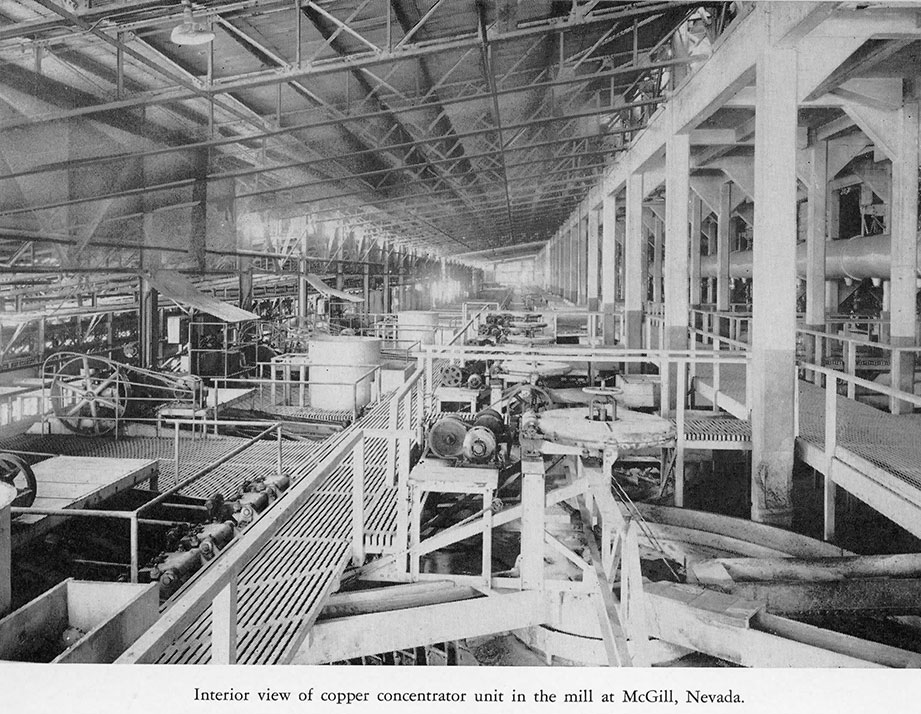 Brucite, another nonmetallic, is produced near Luning on a large scale. A deposit said to contain over a million tons of brucite has been spotted nearby in Nye County While mined in Nevada, brucite is shipped to Ohio refractories where the grayish white material is reduced to a compound for use in alloys. These alloys are used extensively in the steel manufacturing industry While that seems to be the principal utilization of this nonmetallic at the present time, brucite is believed to have a promising future in heavy types of construction work. The ore in Nye County is easily worked, and only a minimum amount of blasting is required to excavate this increasingly needful mineral. To protect their eyes from sunglare which results when the sun strikes the great mass of exposed rock, workmen find it necessary to wear dark glasses.
Brucite, another nonmetallic, is produced near Luning on a large scale. A deposit said to contain over a million tons of brucite has been spotted nearby in Nye County While mined in Nevada, brucite is shipped to Ohio refractories where the grayish white material is reduced to a compound for use in alloys. These alloys are used extensively in the steel manufacturing industry While that seems to be the principal utilization of this nonmetallic at the present time, brucite is believed to have a promising future in heavy types of construction work. The ore in Nye County is easily worked, and only a minimum amount of blasting is required to excavate this increasingly needful mineral. To protect their eyes from sunglare which results when the sun strikes the great mass of exposed rock, workmen find it necessary to wear dark glasses.
Gypsum beds occur near Gerlach, northern Washoe County; in Smith Valley, Lyon County; near Mound House, Lyon County, and adjacent to Arden in Clark County.
A reduction plant treats deposits of pumicite (volcanic ash) near Cobre, Elko County Feldspar occurs in Clark and Esmeralda Counties. Sodium carbonate has been taken from Soda Lake in Churchill County and near Schurz in Mineral County. Salt comes from the many dry lakes in Churchill, Nye, Mineral, Esmeralda, and Eureka Counties. Many of these dry lakes are sources for borax.
Potash alum near Silver Peak, sulphur from Pershing County, and scrap mica from Elko and Clark Counties add to the variety of nonmetallics occurring in the friendly hills of Nevada.
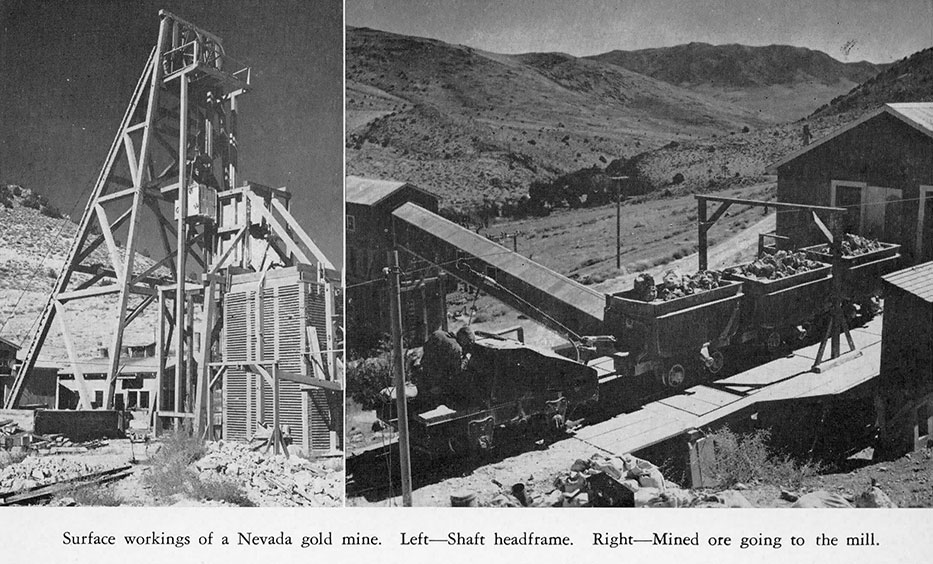
With such a wide field for operations the State’s future mining possibilities seem boundless. While it is a matter of record that many gold and silver deposits have been worked to the point of exhaustion and, as a result, have brought into being the “ghost town,” a comprehensive survey indicates potential ore deposits of very large extent and greater permanence.
Almost every month a new field is announced where metal indications fire the hopes of prospectors and miners. Some of these fields may flash into spectacular prominence, remain in the spotlight for a short time, then fade away into the limbo of forgotten mining camps. Other fields have greater likelihood of surviving, and with scientific exploration plus economical development will be permanent establishments.
The old timers, in spite of their luck, were greatly handicapped. They lacked adequate knowledge of the mode of occurrence, geological relationships, and the association of related minerals. Luck in the early days was a prime requisite, but luck as the main element needed to find a new gold field has lost its charm. New discoveries are most likely to be made by those who are versed in the sciences of geology, metallurgy, and analysis of rocks. This contention has been greatly strengthened in recent years by discoveries now on their way to success through application of scientific methods. The new fields were in many instances found by searchers who were equipped with special training.
The Mackay School of Mines and also the State Bureau of Mines at the University of Nevada have given invaluable service to prospectors and miners following the transition from a lucky horseshoe to scientific application. In one outstanding instance experts from the Mackay School worked out the entire geological column of the Cambrian sediments in the Pioche district where lead and zinc deposits exist. The information furnished by the Mackay School of Mines Hunt Foundation professors and students gave data which led to discovery of a large ore body resting 1,700 feet below the surface. With the aid of the data furnished many other areas in that same district can now be worked out geologically, and further important discoveries are expected. The Mackay School of Mines stands ready to render the same type of service to other districts of the State. Great dependence is placed on this institution by men who search the hills for ore-bearing bodies.
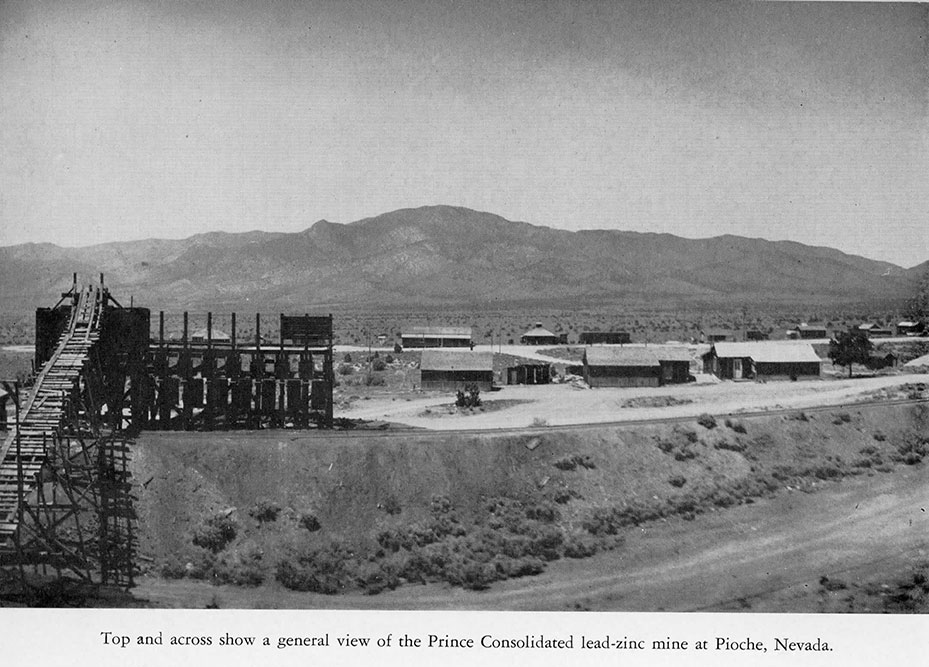
Nevada’s wealth from metals and nonmetallic minerals in the past has been exceedingly great.
With such a vivid picture as an incentive it is small wonder that mining activities are greater now than they have been for many years. Better prices for some of the metals have been a stimulant for greater diligence in the search for “the cleanest wealth in the world.” With intelligent handling and study, proper financing and development, many new fields will add to this prosperity. Even old fields which years ago promised little, because of the low values or difficulty in reducing complex ores, are now yielding profits in abundance.
The $1,600,000,000 of new wealth produced from Nevada’s mines during the past 75 years, while of major significance, has not by any means reached its limits. In fact, men of science, after a thorough survey of the possibilities as viewed from all angles, are in perfect agreement that there is more wealth underground in this State than has ever been taken from the ground. It awaits only the application of intelligent effort for mankind to transpose this latent wealth from dormancy into living riches.
Nevada truly offers an opportunity in the field of mining.

